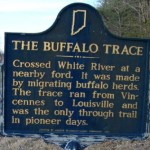Today we eagerly track packages online. Will our order arrive as promised in two days? Will the US Postal Service, or Fed Ex, or UPS, or any one of a dozen other carriers arrive at our door on the day we expect? When will that mail arrive, anyway?
Residents of Vincennes and the few other towns in Indiana Territory in 1800 knew the answer to that question all too well. Before that year, all mail going out of Indiana had left from Vincennes, on an uncertain schedule, and from there traveled either to Louisville or Cincinnati and then from one of those cities to its final destination.
In 1800, the postal service finally established a weekly there-and-back-again route from Vincennes to Louisville. Every Friday morning, mail arrived in Vincennes from Louisville; by 2 p.m. the outgoing mail left Vincennes and then arrived back in Louisville by 5 p.m. the next Monday. The mail carrier left Louisville again on Tuesday morning by 8 a.m. to repeat the cycle. Carriers were responsible for delivery in all kinds of weather—they could claim inability to reach their destination but if any other traveler could get through by any means, the mailman was penalized.
Vincennes residents who wanted their mail to go westward to the settlement in Kaskaskia were less fortunate. The government was unable to find a contractor willing to make a weekly trek into the wilderness to deliver mail to the relatively miniscule number of citizens who, in 1800, lived anywhere beyond Vincennes—instead, mail delivery occurred once every four weeks.
As the Indiana Territory grew, the number of post offices slowly increased. In 1809, Corydon acquired its own office; by 1812, territorial representative Jonathan Jennings used his influence to bring a weekly postal route through Madison and Jeffersonville. By 1814, as Indiana approached statehood, residents could boast 16 post offices and a growing number of post roads through their territory.
Source: Howard Peckham, “Mail Service in Indiana Territory,” IMH, vol. 47, June 1951.
A Moment of Indiana History is a production of WFIU Public Radio in partnership with the Indiana Public Broadcasting Stations. Research support comes from Indiana Magazine of History published by the Indiana University Department of History.























